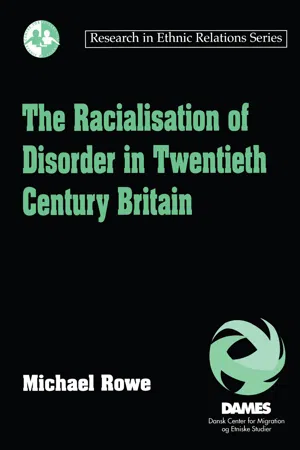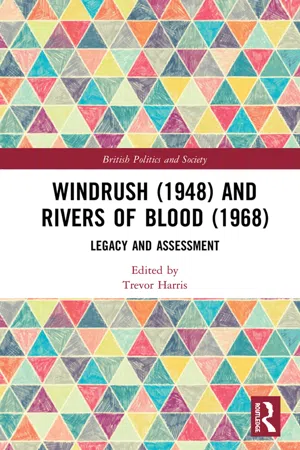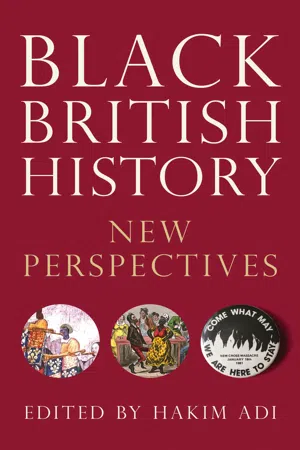History
Notting Hill Riots
The Notting Hill Riots were a series of racially motivated clashes that occurred in London, England, in 1958. Sparked by growing tensions between white and black communities, the riots resulted in violence, property damage, and numerous injuries. The events prompted a national conversation about race relations and immigration in post-war Britain.
Written by Perlego with AI-assistance
Related key terms
5 Key excerpts on "Notting Hill Riots"
- Michael Rowe(Author)
- 2017(Publication Date)
- Routledge(Publisher)
Much of the recent literature discussing the disorders of 1958–59 ignores an important and interesting kind of response which involved the establishment of voluntary groups intending to promote ‘racial tolerance’ and integration (Fryer, 1984; Miles, 1984; Pilkington, 1988; Solomos, 1993). On the surface, it appears that these initiatives were based upon different assumptions to those implied in many of the arguments above, because they were more sympathetic to the position of the black victims of the disturbances. Such initiatives were reinforced by the statements condemning racial discrimination that were issued by various bodies, including the Labour Party, the British Council of Churches, the Conservative Commonwealth Council. The ‘Keep Britain Tolerant’ (Glass, 1960) groups varied in their membership and longevity, with many of them apparently fading as soon as the initial violence waned. The local authority for the Notting Hill area appointed a black social worker and the Mayor established a ‘Racial Integration Coordinating Committee’ consisting of representatives of various local organisations and members of the public with ‘the general, rather vague purpose of promoting harmony in the borough’ (Glass, 1960: 195). As a direct result of the disorders, the British-Caribbean Association was established in order to develop ‘friendship and understanding’ between the peoples of the Caribbean and Britain.Although apparently divergent from the more common arguments outlined in earlier sections, the operations of these groups were based upon a similar model of ‘race relations’ which assumed that racial discrimination was a ‘real’ phenomenon — arising from cultural differences and misunderstanding. Educational initiatives, in the broadest sense, could enlighten those sections of the white population whose ignorance led to antipathy towards ‘strangers’. Forty years later many of the initiatives seem naive and patronising to all concerned and they certainly failed to consider the structural and ideological nature of racism. Other objections were raised at the time. Malik (1968: 79) recalled with some incredulity how:As a result of the trouble, Notting Hill gained official recognition as a problem area and sociologists, professional and amateur, began to flood the area, together with their cohorts of students, titled ladies and do-gooding young middle-aged women. They literally came in droves — all of them terribly well-intentioned, quite clueless and full of questions. They all wanted to do something for the poor, unfortunate residents of Notting Hill and they were desperate to meet us.The objections raised by others assumed that the initiatives would be unlikely to succeed. Glass (1960: 197) cited an interview with Councillor Olive Wilson, reported in the Kensington News on 30 October 1958. Under the headline WILL TOO MANY DO-GOODERS PAVE THE PATH TO NOTTING HELL- eBook - ePub
Reading the Riot Act
Reflections on the 2011 urban disorders in England
- Rupa Huq MP(Author)
- 2018(Publication Date)
- Routledge(Publisher)
Yet, the various commentaries have all implied other starting points – almost no one argues that the killing of Duggan is the very beginning. This terrible incident may have been the immediate spark, but the orthodoxies of riot analysis remind us that the ostensible trigger is a reminder or reference to longer standing grievances or tensions. The point of interest, then, is not so much why this incident ignites this chain of reactions, but why so many other incidents do not. There has been no shortage of police killings in recent years – among them, Kingsley Burrell and Demetre Fraser in Birmingham, Anthony Grainger in Manchester and Smiley Culture in his own home, a death that caused a great deal of concern and protest in Caribbean and other communities.Farrar argues persuasively that we need to learn a more nuanced language and analytic framework to understand the varieties of violent urban protest that are grouped under the term “riot” and considers what can be learned and reworked from scholarly attempts to place the event of “riot” in a larger social and historical context (Farrar 2009, pp. 103–118). Yet, even these attempts to place unrest in a wider context of ongoing social relations can tend towards stock explanations. If we decide that the significance of events cannot be discerned through attention to uniquely remarkable incidents, then the longer contextual narratives veer towards the stories that have already been told. In Britain, this can mean that riots are about race – and, conversely, the street unrest of markedly white groups, say in relation to football, is not a “riot”.A painful demonstration of these racialised codings was seen in the patterns of sentencing following disturbances in Bradford in 2001. Here, the proposal to allow the British National Party to march through predominantly Asian neighbourhoods of Bradford led to local resistance, with young Asian men occupying their local streets as a mark of self-defence. Disturbances followed in both Asian and white neighbourhoods, with animosity directed towards the police, yet only Asian men were charged under the terms of “riot” and given the disproportionately long sentences that are enabled by that definition of disorder. White participants from neighbouring areas were charged with lesser offences under the rubric of public order (for more on the disturbances in Bradford, see Bagguley and Hussain). - eBook - ePub
Windrush (1948) and Rivers of Blood (1968)
Legacy and Assessment
- Trevor Harris(Author)
- 2019(Publication Date)
- Routledge(Publisher)
Empire Windrush docked in 1948 it carried inside it the seeds of a new Britain. Windrush would herald a new multicoloured and multifaceted world of fashion, music, food and, most importantly, people. However, in the decade that followed Windrush, there would also be an open political resistance to this fledgling multicultural society. Political organisations openly hostile to Caribbean immigration began to organise, in particular, Oswald Mosley’s Union Movement (UM) and the newly formed White Defence League (WDL). Both organisations established their headquarters in Notting Hill, West London, and began sustained campaigning, the culmination of which saw two events place immigration at the forefront of British politics: the Notting Hill Riots of 1958 and the General Election of 1959. The purpose of this chapter is to examine these events and the role played by the far-right inside them. It is also to introduce to the reader an important political and cultural opposition to the far-right, a hitherto “lost history” of anti-racist struggle in British history. It examines the Stars Campaign for Interracial Friendship (SCIF), an anti-racist/-fascist organisation of musicians and celebrities that grew out of the ashes of the Notting Hill Riots of 1958. SCIF’s sole purpose was to use the music of its members to counteract the racism of Oswald Mosley’s Union Movement and Colin Jordan’s White Defence League. This chapter will deal solely with SCIF, but is the first part of a wider work that will examine the relationship between music and anti-fascism in post-World War II Britain. My research will go on to compare and contrast the three main organisations that have sought to marry music and a political opposition to racism. These organisations are SCIF in the 1950s, Rock Against Racism (RAR) in the 1970s and Love Music Hate Racism (LMHR), active from 2002 to the present day.In the summer of 1958 riots broke out on the streets of Nottingham and Notting Hill. Like all riots, at their origin were many complicated social, economic and political factors that had contributed to their eruption. Against a backdrop of slum housing, “concerns” over employment and interracial marriage was a nascent racism against the newly arrived Afro-Caribbean and Asian communities. However, the riots did not follow the same narrative in Nottingham and Notting Hill, so what was different? Why did the violence in Nottingham not escalate and what was the response to the rioting in Notting Hill?Windrush arrivesBritain has always been a multi-racial society – sometimes seen and sometimes hidden. As the possessor of the largest empire in history, a slave-trader par excellence and with London for centuries the financial capital of the world, the movement and exchange of cultures and peoples were inevitable. There has been a black community in London for five hundred years; Liverpool has housed the biggest Chinese community outside China since the 1850s; Bristol has records of a slave or freed slave enclave for some four hundred years; and following the arrival of the East India Company in the Indian sub-continent, there has been an Asian presence in the United Kingdom since the early seventeenth century. As Britain impacted upon the world, so the world affected change on her. Revolutionary upheavals in Europe, the collapse of rival empires and war all contributed to the ever-changing ingredients that became modern Britain. - eBook - ePub
- David Waddington, Fabien Jobard, Mike King(Authors)
- 2013(Publication Date)
- Willan(Publisher)
Guardian in response to the riots in Burnley bore the headline, ‘Years of harmony wrecked in days’ (26 June 2001). As will be argued below, such responses demonstrate an ignorance, or denial, on behalf of the media and politicians of the local political contexts within both Burnley and Oldham. Keith identifies a similar lack of historical knowledge in the coverage of the 1981 riots in London:The context in which police/Black antagonism briefly flowered in 1981 was unremarkable if the spatialities of the specific locations are understood. This conflict itself was a historical product, accessible to most of the Black community as a form of ‘local knowledge’, violence only one of many manifestations of it … In this sense, conflict is not synonymous with confrontation. (1993: 169; emphasis in original)Keith suggests that it was not unrest itself but the ‘qualitative and quantitative scale of seriousness of disorder’ that distinguished the 1981 London riots (ibid.: 70). Beyond this, ‘the forms of collective behaviour that were seen in the summer of 1981 were not new to the streets of London, or novel in the recent past’ (ibid.). Rather, past incidences had been largely ignored or under-reported within the media. It is important instead to view the riots as a point of intensity within the routine of daily lives which are marred by omnipresent conflict of varying degrees. In this sense, the disturbances need to be situated within a context of annual summer disturbances between the police and younger urban males. In Glodwick, the scene of the unrest in Oldham in 2001, only the previous year a double-decker bus was stolen and used to barricade the main road. Indeed, it is the persistence and continuities of everyday racialised tension that are rarely mentioned within media coverage or governmental discourses, which present an ongoing backdrop to normal - eBook - ePub
Black British History
New Perspectives
- Hakim Adi, Hakim Adi(Authors)
- 2019(Publication Date)
- Zed Books(Publisher)
5 BEFORE NOTTING HILLThe Causeway Green ‘riots’ of 1949Kevin Searle1The dominant narrative of post-war ‘race’ relations in Britain begins with the Empire Windrush bringing the earliest Caribbean workforce, and the anti-black riots of 1 958 on the streets of Nottingham and Notting Hill signalling the first major instances of ‘race-related’ public disorder.2 But there was an earlier phase to this history – one that saw flashpoints between workers of different nationalities housed in Ministry of Labour hostels during the late 1940 s. It was in fact the ‘racial’ policies of such hostels and their handling of potential enmities that may well account for later long-term black settlement patterns. This chapter examines this neglected aspect of Black British History, concentrating on events at Causeway Green, West Midlands, in 1949 , when European volunteer workers turned on Jamaicans, attempting to run them out of the hostel, which resulted in restrictions on the number of black workers allowed to stay in government hostels at any one time.This chapter is based largely on research into the collections of local newspapers held at Birmingham Central Library and grey material at the National Archives.3 It explores the disturbances at Causeway Green, as well as responses from the community and official agencies, which would attempt to remove the black tenants and implement a restrictive quota system for them across the hostels.Post-war Britain faced a massive shortage of labour – estimated at 1 ,346 ,000 at the end of 1946 4 – and the government tapped a number of sources of labour, including ex-prisoners of war (POWs), Polish ex-servicemen and eventually the European Voluntary Workers (EVW) scheme. There were an estimated 7 ,000 Polish workers labouring in the mines, foundries and factories of the Midlands,5 the majority of whom had come under this scheme, which ran until the early 1950 s and recruited Eastern European refugees from the displaced persons camps in Germany and Austria to work in a particular range of industries that were experiencing labour shortages. The scheme was deeply discriminatory: given the Poles’ status as aliens, they could be directed to, and kept within, certain undermanned and frequently undesirable sectors of employment, a status that clearly differentiated them from Caribbean migrants. As British citizens, Caribbean workers were exempt from such controls. Thousands of West Indians had come to Britain during the war, either as volunteers in the armed forces or as technicians, and while a few remained, the majority returned home. It was the shortage of opportunities, and the underdevelopment of the islands under colonial rule, that provided the impetus for many more to seek employment in the ‘mother country’ in the late 1940 s.6
Learn about this page
Index pages curate the most relevant extracts from our library of academic textbooks. They’ve been created using an in-house natural language model (NLM), each adding context and meaning to key research topics.




